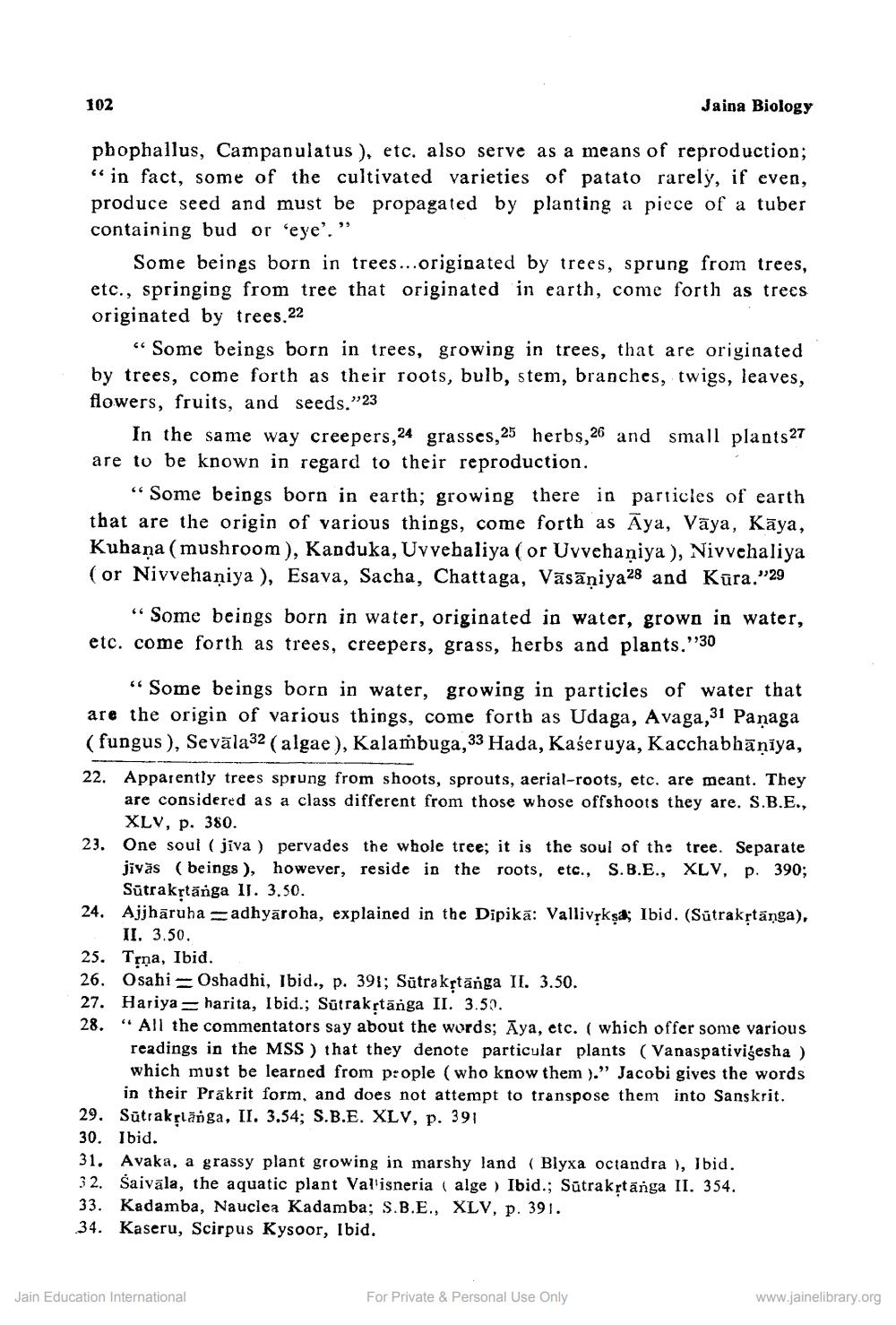________________
102
Jaina Biology
phophallus, Campanulatus ), etc. also serve as a means of reproduction; “ in fact, some of the cultivated varieties of patato rarely, if even, produce seed and must be propagated by planting a piece of a tuber containing bud or ‘eye'.”
Some beings born in trees...originated by trees, sprung from trees, etc., springing from tree that originated in earth, come forth as trees originated by trees.22
“Some beings born in trees, growing in trees, that are originated by trees, come forth as their roots, bulb, stem, branches, twigs, leaves, flowers, fruits, and seeds."23
In the same way creepers, 24 grasses,25 herbs 26 and small plants27 are to be known in regard to their reproduction
“Some beings born in earth; growing there in particles of earth that are the origin of various things, come forth as Āya, Vāya, Kāya, Kubana (mushroom), Kanduka, Uvvebaliya ( or Uvvehaniya ), Nivvehaliya (or Nivvehaniya ), Esava, Sacha, Chattaga, Vāsāniya28 and Kūra."29
“Some beings born in water, originated in water, grown in water, etc. come forth as trees, creepers, grass, herbs and plants.''30
“Some beings born in water, growing in particles of water that are the origin of various things, come forth as Udaga, Avaga,31 Paņaga (fungus), Sevāla32 (algae), Kalambuga, 33 Hada, Kaseruya, Kacchabhāniya,
22. Apparently trees sprung from shoots, sprouts, aerial-roots, etc. are meant. They
are considered as a class different from those whose offshoots they are. S.B.E.,
XLV, p. 380. 23. One soui (jiva ) pervades the whole tree; it is the soul of the tree. Separate
jivās (beings ), however, reside in the roots, etc., S.B.E., XLV, p. 390;
Sūtrakṣtănga II. 3.50. 24. Ajjhāruha =adhyāroha, explained in the Dipikā: Vallivěkşa; Ibid. (Sūtrakstānga),
II. 3.50. 25. Trna, Ibid. 26. Osahi - Oshadhi, Ibid., p. 391; Sūtrakrtānga II. 3.50. 27. Hariya - harita, Ibid.; Sütrakrtānga II. 3.50. 28. “All the commentators say about the words; Āya, etc. ( which offer some various
readings in the MSS) that they denote particular plants (Vanaspativisesha ) which must be learned from people (who know them ).” Jacobi gives the words
in their Prakrit form, and does not attempt to transpose them into Sanskrit. 29. Sūtrakplānga, II. 3.54; S.B.E. XLV, p. 391 30. Ibid. 31. Avaka, a grassy plant growing in marshy land (Blyxa octandra ), Ibid. 32. Saivāla, the aquatic plant Vallisneria (alge ) Ibid.; Sūtraktānga II. 354. 33. Kadamba, Nauclea Kadamba; S.B.E., XLV, p. 391. 34. Kaseru, Scirpus Kysoor, Ibid.
Jain Education International
For Private & Personal Use Only
www.jainelibrary.org




